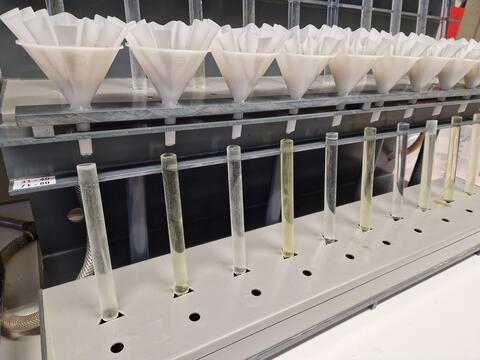Weinbergsboden
Leistungsspektrum: Weinbergsboden
- Grundnährstoffuntersuchung (Makronährstoffe P, K, Mg; Bodenart nach Fingerprobe, pH-Wert)
- Spuren-/Mikronährstoffe (Mn, Cu, Zn, B, Na)
- Nmin
- Humusgehalt, Gesamt-N, C/N-Verhältnis
- Kalkgehalt
- Salzgehalt/elektrische Leitfähigkeit
- Korngrößenverteilung und Bodenart
- Physikalische Bodenuntersuchungen (Schüttdichte, Trockenraumdichte, Wasserkapazität, Wasserrückhaltevermögen)
- Schadstoffuntersuchungen(Pflanzenschutzmittelwirkstoffe, Dioxine, PCB, PFAS, Schwermetalle)
- Kationenaustauschkapazität
- Mikrobielle Biomasse
- Radionuklide
Untersuchungspakete
Wir bieten für Ihre Weinbergsbodenproben ausgewählte Untersuchungspakete an, mit denen Sie mehrere Leistungen gleichzeitig bei uns beauftragen können. Mehr dazu erfahren Sie hier.
Häufig gestellte Fragen
Wann muss eine Düngebedarfsermittlung durchgeführt werden?
Bei Ausbringung über 50 kg Stickstoff / 30 kg Phosphat ist die Bedarfsermittlung für jeden Schlag oder jede Bewirtschaftungseinheit durchzuführen. Detailliertere und aktuelle Informationen können Sie den Seiten der Düngeberatung der Dienstleistungszentren Ländlicher Raum (DLR) Rheinland-Pfalz entnehmen.
Wieviel Probenmaterial wird für eine Routine-Bodenuntersuchung benötigt?
Für Routineuntersuchungen (Grund- und Mikronährstoffe, Nmin, Humus, Nges) benötigen wir ca. 300 – 500 g Probe ("halbe Zuckertüte").
Muss die Probe während des Transports zur LUFA gekühlt werden?
Für die Untersuchung von Grund- und Mikronährstoffen, Schwermetallgehalten sowie dem Humus- und Gesamtstickstoffgehalt muss die Bodenprobe nicht gekühlt werden.
Für die Untersuchung von Bodenproben auf Nmin und Smin (im Weinbau eher nicht relevant), Pflanzenschutzmittel und deren Rückstände sowie mikrobiologische Eigenschaften muss von Probenahme bis Ankunft im Labor eine maximale Temperatur von 4 -7 °C eingehalten werden. Hierfür eignen sich einfache Kühl- oder Styroporboxen mit ausreichend Kühlakkus.
Kurz erklärt
Nährstoffuntersuchungen Seit dem Gesetz vom Minimum (Carl Sprengel, 1828) gilt: Das Pflanzenwachstum ist durch die knappste Ressource eingeschränkt. Die Bodenuntersuchung, insbesondere auf die 12 essentiellen Pflanzennährstoffe, ist daher Grundvoraussetzung für eine bedarfsgerechte Düngung der Kulturpflanzen und teils im Rahmen der Düngebedarfsermittlung gefordert. |
Grundnährstoffe Bild

Unsere Untersuchungspakete der Grundnährstoffe beinhalten standardmäßig die Parameter Bodenart, pH, Phosphat und Kali im CAL-Extrakt sowie Magnesium im CaCl2-Extrakt, welche in Abständen von drei bis vier Jahren untersucht werden sollten. Diese sind erweiterbar um die Untersuchungen von Bor im CAT-Extrakt, Humus (Dumas) und Gesamt-N (Dumas). |
Mikronährstoffe Insbesondere die essenziellen Mikronährstoffe Kupfer, Zink, Mangan und Bor sollten alle sechs Jahre untersucht werden. |
Nmin / Smin Bild

Der Gehalt an Nitraten und Ammonium aus feldfeuchten Proben zur Ermittlung flächenbezogener Gehalte mineralischen Stickstoffs meist dreischichtiger Bodenprofile ist unmittelbar pflanzenverfügbar und wird für die Düngebedarfsermittlung benötigt. Der Gehalt an Nmin (und bei Bedarf von Smin) sollte jedes Jahr im Frühjahr beprobt werden. |
Bodenart Bild

Zur Einteilung des Nährstoffzustandes in Gehaltsklassen ist die Kenntnis der Bodenart nötig. Diese wird im Rahmen der Grundnährstoffuntersuchungen routinemäßig per Fingerprobe ermittelt. |
Physikalische Bodenuntersuchungen Bild Bild

Korngrößenverteilung: Die Zusammensetzung der Korngrößen wird per Sedimentations- und Siebanalyse genau bestimmt, wahlweise nach DIN (3 – 7 Fraktionen) oder USDA (3 – 9 Fraktionen). Wasserhaushalt: Der Wasserhaushalt von Böden ist eine wichtige Standorteigenschaft und beeinflusst maßgeblich deren Produktivität. Maximalen Wasserhaltekapazität: Die maximale Wasserhaltekapazität beschreibt, wie viel Haft- und Kapillarwasser maximal gegen die Schwerkraft gehalten werden kann und nicht versickert. Wasserrückhaltevermögen: Durch Anlegen von Unterdruck auf wassergesättigte Bodenproben wird das Wasserrückhaltevermögen untersucht. Dieses wird u.a. für mikrobiologische Abbaustudien oder zur Bildung von pF-Kurven zur Bestimmung der nutzbaren Feldkapazität benötigt. An der LUFA Speyer werden pF-Werte von 1 bis 2,88 untersucht. |
Schwermetalle Schwermetalle können unter anderem aus der Industrie, starkem Verkehr oder Überschwemmungen in Böden eingetragen werden. Gerne prüfen wir, ob und wie sehr Ihre Böden mit Blei, Cadmium, Kupfer, Zink, Quecksilber, Chrom, Nickel, Arsen oder Thallium kontaminiert sind. |
Auftragsformulare und Anleitungen
Ansprechpersonen






